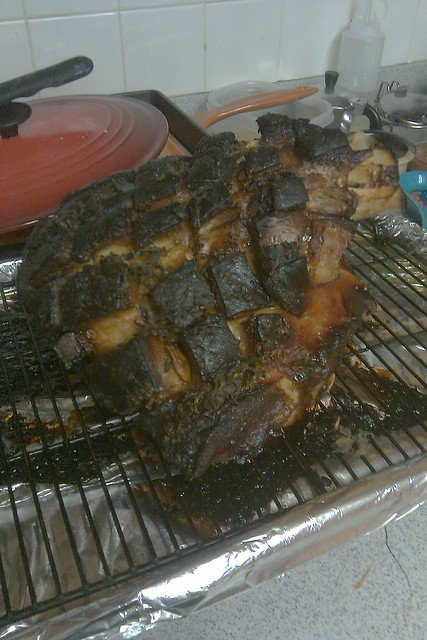Tiki drinks are a whole geeky subcategory of bartending nerddom, with their own obscure hardware and software. The ingredients themselves aren't hard to find (for the most part), but they're combined in ways that create a lot of complexity.
One of those ingredients is orgeat (or-zhat) syrup, which originated in France based on barley but is now usually an almond syrup flavored with orange flower and rose water. You can buy some commercial versions, but if there are any good ones they're hard to find and it's really easy to make at home. Kaiser Penguin's recipe was the basis for this one--I haven't changed it much.
Orgeat
(makes about two quarts)
1/2 lb almonds
2 1/2 pounds sugar
8 cups water
rose water
orange flower water (you can find these at the hippie grocery, or at a Middle Eastern or Indian grocery)
Grind almonds as finely as possible in the food processor. (You can use almond flour if you can find it, but it's more expensive that way.) Toast the ground almonds briefly in a dry saucepan, being careful not to burn them. (It happens fast.) Add the water and a pound of the sugar and bring it all to a boil. Simmer for about ten minutes, stirring to dissolve the sugar, then turn off the heat, cover the pot, and let it sit overnight.
The next day, strain the syrup through some cheesecloth and return it to the saucepan. Bring to a boil and then stir in the rest of the sugar. Turn it off, let it cool, then add drops of rose and orange flower water to taste (a little goes a long way).
Store in jars in the fridge. There will still be a lot of solid in it that rises to the top; just shake it before you use it. Aside from the Mai Tai (below), you can use it in the Japanese Cocktail--1/2 oz orgeat, 2 oz brandy or cognac, and 3 dashes Angostura bitters, shaken with ice and served up with a lemon twist. Outside the cocktail world, it's awesome in a Cafe Au Lait, and great with soda water.
--
The Mai Tai is a tiki classic, one of the drinks that put Trader Vic's and Don the Beachcomber on the map. These days it has become almost a generic term for anything fruity and rummy with an umbrella in it, which is a real shame. Cocktails like this one with so many ingredients usually blend together into noise, but the different flavors in this one play off one another so well that the whole really is greater than the sum of the parts.
I've expressed the recipe as a ratio. As always, I suggest using a kitchen scale for cocktails. Using 1/2 oz as your "one part" will make enough for two powerful drinks.
Mai Tai
1 part simple syrup
2 parts lime juice
3 parts orange curacao
3 parts orgeat
6 parts white rum
6 parts dark rum (I like Cruzan blackstrap--it's not traditional, but it's tasty)
Shake all ingredients except the dark rum with ice. Pour over clean ice in a rocks glass. Using a bar spoon or just a really careful pour, pour the dark rum on top so that it forms a layer on top. Garnish with a maraschino cherry and a pineapple chunk on a toothpick and a little umbrella if you have one. Add a neon-colored bendy straw. (The straw is imperative, as it needs to be drunk from the bottom.)


